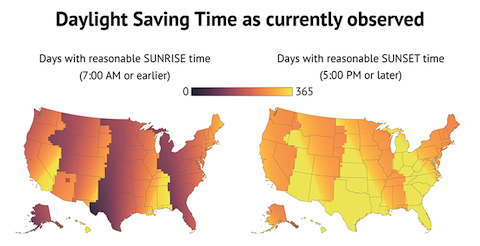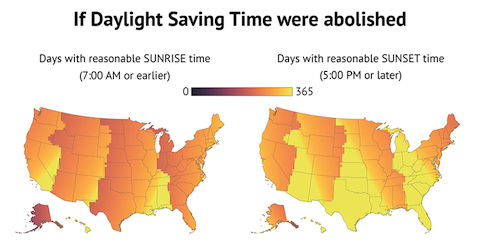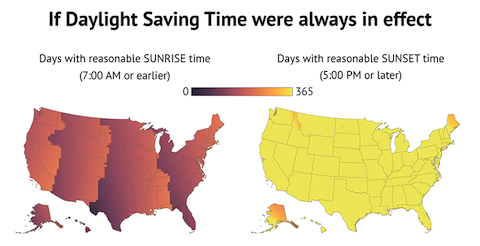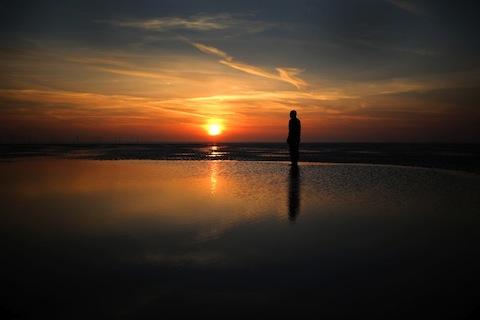This Sunday, our clocks will be set back an hour. And many of us will be able to enjoy an extra hour of sleep.
But the one-time benefit of a little extra sleep does not make up for the fact that there will be much less light in the evening hours. People who work 9 to 5 will, in a few weeks’ time, leave their offices in total darkness.
Daylight saving time in the US started as an energy conservation trick during World War I, and became a national standard in the 1960s. But many now feel it has outlived its usefulness. For one, the presumed electricity savings of taking advantage of more daylight in the evening during the summer turn out to be unclear or nonexistent.
Why extending daylight saving time all year would make our evenings brighter
So how might our patterns change if Congress abolished or extended daylight saving? Blogger and cartographer Andy Woodruff decided to visualize this with an excellent series of maps.
Reasonable, as defined by Woodruff, is the sun rising at 7 am or earlier or setting after 5 pm (so one could, conceivably, spend some time in the sun before or after work).
This is what the map looks like under the status quo of twice-yearly clock shifts. A lot of people have unreasonable sunrise times (the dark spots) for much of the year:

Here's how things would change if daylight saving were abolished (that is, if we just stuck to the time set in the winter all year). It’s better, particularly on the sunrise end:

And here's what would happen if daylight saving were always in effect. The sunrise situation would actually be worse for most people. But many more people would enjoy after-work light — and there’s a strong argument to make that this after-work light is actually worth more. (More on that below.)

(Note: The length of light we experience each day wouldn't actually change; that's determined by the tilt of Earth's axis. But we would experience it in times more accommodating for our modern world. Be sure to check out the interactive version of these maps on Woodruff’s website.)
Why it’s better to have more light in the evening hours.
In 2015, Joseph Stromberg made the compelling case at Vox that the daylight saving time shift into the evening should be extended year-round. Having more light later could benefit us in a surprising number of ways:
- People engage in more leisure activities after work than beforehand, so we’d likely do more physical activity over sedentary leisure activities. Relatedly, studies show that kids get more exercise when the sun is out later in the evening.
- Stromberg also cites some evidence that robberies decrease when there’s more sun in the evening hours.
- There could be economic gains, since people “take short trips, and buy things after work — but not before — so a longer DST slightly increases sales,” Stromberg writes.
Extending daylight saving time would also resolve another troubling consequences of changing the clock: car crashes.
In 1999, researchers at Johns Hopkins and Stanford universities wanted to find out what happens on the road when millions of drivers have their sleep disrupted.
Analyzing 21 years of fatal car crash data from the US National Highway Transportation Safety Administration, they found a very small, but significant, increase of road deaths on the Monday after the clock shift in the spring: The number of deadly accidents jumped to an average of 83.5 on the "spring forward" Monday compared with an average of 78.2 on a typical Monday.
So let’s recap: Switching between daylight saving time and standard time doesn’t save energy, it decreases the amount of daylight office workers see in the winter, it possibly puts a damper on sales, it discourages kids from exercising, and it may cause some auto accidents. So why keep changing the clock?


Spread the word